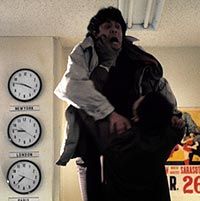I've had to seriously alter my cinematic diet as of late. After years spent working for Movieweb, my arteries have become hardened with the dripping creosote of Hollywood excess. Yes, sadly, I've visually downed one too many fast food, conveyer belt endeavors. And that certain type of irresponsible consumption has taken its toll. I'm fat and bloated. This sickly yellow aura surrounding my body is made of an unnatural light. I'm suffering malnutrition, and I've had to back peddle the ornate circus of crap that comes to my door on a daily basis.
This doesn't mean I've quit going to the Maitreyaplex altogether. I manage to skip through a few worthless journeys every now and again. I just choose wisely and plan accordingly. I no longer dive head first into whatever media schlockfest is pimping itself in a given week. Instead, I substitute my cinematic menu with various unseen classics that have defined each and every given genre. I also sprinkle in at least three or four foreign flicks a month. Most of these coming from Japan. Why Japan? Because I love this country's aesthetic means to keep the medium alive. They're breathing through with one of the most original collective voices in modern cinema. And they like spiting violence, harked up from the back of a conflicted throat. It's this visceral type of damage that turn all my internal bruises a nice shade of violet and amber brown. I can literally feel the itch peeling away at my chest like a swimming pool sunburn; and this branded type of J-shock pleases my ocular senses.
It's been a few weeks since I took time to read copious amounts of yellow subtitles. The pastime has eluded me on purpose. I've depleated most of the foreign surpluses at my disposal, and Amoeba Records can become a spendy habit. Sometimes I give into their "thirty dollar a disc" whims, but my wallet hates cramps and it's bleeding. Luckily, the fine folks at Artsmagic come through with their own brand of quality entertainment on a rotating basis. This past week, they sent me another fine batch of flicks to view and discuss. As always, their latest entries, in an ever-expanding catalogue of Asian cinema, proved to be thought provoking and original endeavors worthy of my Best Buy Gift Card.
Here are two A+ entertainments that I can't recommend highly enough.
Wild Life
First up is Wild Life, based on a book by Kurokawa Hiroyuki and directed by one of Japan's most vicious visual screamers Aoyama Shinji, who also made the soon-to-be released Em/Embalming (headed your way June 28th). Wild Life was originally released in 1997, and is finally making its way to American Shores this August.
Those unfamiliar with the scattershot headboard editing of most fast-paced Japanese fare may be a little put off Wild Life at first, but if they stick with it, they're in for a real treat. The film sears onto the screen with a bullet train momentum that never loosens its hold on the viewer's unsuspecting face. Quick clips move at a fevered jaunt, instinctively ordering you to catch up and catch your breath. Before you can grasp at the narrative with an outstretched arm, it shoots in a wholly omnipresent direction that is nerve wrecking. It's of an opliforious nature, and it purposely gives away its game-like nature with one early, telling shot.
Sitting on a coffee table is an incomplete jigsaw puzzle. The frame has been pieced together, but the majority of the image is left scattered about the box. That's exactly what this film is; an interlocking 500-piece MB puzzle that the viewer has to put together quickly in order to see the whole picture. It's a smart metaphor in structure, but the coy descriptive nature of the narrative doesn't end there. Sakai Hiroki (played by Toyohara Kosuke) is the right-hand man of pachinko operation magnate Tsumura Kenzo (Mickey Curtis). When Sakai first visits one of the Pachinko Palaces, its insubordinate owner describes the inner-workings of this peculiar plinking noise machine, and later on we realize that Sakai's own life closely mirrors that of the little metal ball so favored by Pachinko enthusiasts. Like many popular Tokyo-infused outings, Wild Life gleefully wears its metaphors on its sleeve.
It's hard to pin down the enthused nature of this flick. Its many flavored pieces hit at nailing various different genres like a rainbow slide into oblivion. Sometimes it plays like a comedy, but it also eases itself into the realms of neo-noir and romance. It likes to hit all four corners of the tongue in a means to be a salty-sweet, somewhat bitter, somewhat sour confection of conflicted emotions. The storyline is all-over the place, and its timeline of events is wittingly shifted out of order. The beauty rests in Aoyama's adroit editing skills. He is able to pull us from one point in time to another with a death defying balancing act that keeps Wild Life humming well past ending credits.
Upon first viewing the flick, it left me slightly confused. At the twelve-minute mark, I had to shut off the film and start it over; it's dizzying pitch shaking my brain into a stupor. This unbridled uncertainty of events gives Wild Life a nervous energy that's hard to resist. Having no idea which way this thing is bound to go is one of the main joys of watching it. It's a thoroughly unpredictable romp that bounces and bucks with various differing degrees of retribution.
The main throughline centers itself on Sakai's search for his boss, Tsumura. Soon after the Pachinko owner's disappearance, Sakai is confronted by a Kyoto gangster in need of a mysterious envelope. Throw in a couple of foreign hostesses, a queer cop, and a bit of police corruption, and you have one Hell of a good time sitting inside your DVD player, waiting for you to push play. There's also a bit of murky romance business between Sakai and his boss's daughter thrown in for good measure. A lot of clues are tossed towards the conclusion of this pseudo mystery, but quite a few are rendered less than significant. It's all part of the fun sandwich Shinji has concocted here. Wild Life refuses to take itself as seriously as Em/Embalming did.
This is a pitch perfect endeavor for hardcore film enthusiasts. Guaranteed.
The Guard from the Underground
The Guard from the Underground is requisite viewing for the splat enthusiast. If you're a fan of late 70s-early 80s horror hack-em ups, then you'll dig on this with great aplomb. Kiyoshi has studied, and subsequently loves, the slasher genre. And it's easy to identify the influences seen on screen. He sites Hooper's 1974 classic The Texas Chainsaw Massacre as the main staple of his auteuristic diet. The swept-in, genre defying camera work, as well as the overwhelming sense of claustrophobic malevolence often associated with Tobe's earlier films is scattered throughout the proceedings here, but it never reads as a sliding door rip-off. Kurosawa pinches off little nibbles of a move, and then spreads them into his own systematically trained cuff of indelible horror. The film is incredible violent, at first starting out as a bloodless affair but slowly building into a crescendo of crimson terror. Put simply, it's an awesome throwback to guilt free exploitation flicks and grindhouse viscera.
Check this sh*t out. It's a must. Especially for J-pop loving slash aficionados.
Both of these films are radical rental night choices. Wild Life is the slightly better effort, but they both hold a lot of entertainment value for your buck. If you don't feel like purchasing them for lack of shelf space, your best bet is to put them into your rotating cue on Netflix. Looking at their website's current crop of new releases, I can't think of two better time killers.
Thank you for your time. And remember to support Japanese cinema. It may be our last bastion of hope for something original. Visit the Artsmagic website at www.artsmagicdvd.com...



